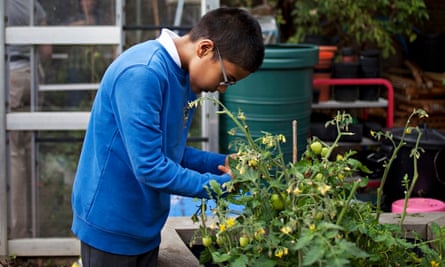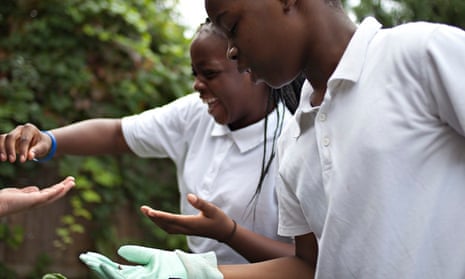16. The Secret Garden
“I used to run past here on the way to school,” remembers headteacher Colette Morris. “I would think: ‘What’s in there? Either they’re really big lockups or there’s something in there.’”
The Guardian’s product and service reviews are independent and are in no way influenced by any advertiser or commercial initiative. We will earn a commission from the retailer if you buy something through an affiliate link. Learn more.
Colette approached the chair of the local residents’ association for the Falcon Estate, which borders the school, and was told that behind the high wall was a former allotment site that had fallen into disuse. She saw the potential of such a space for her pupils, and the residents’ association helped her to arrange the lease.
Along the alleyway and behind a black metal door is now the secret garden of Christ Church CE primary school in Battersea, south London; a verdant kingdom of beetroot and chard, and fat, round pumpkins. There are glassy-leaved young apple trees standing pale and slender in the September sunshine, rows of raspberry bushes, still plump with heavy fruit, and in every gap and crevice spring tomato plants that curl and tumble with gleeful unruliness.
Today Colette and seven of her pupils from years five and six are giving me a guided tour, pointing out the gaggle of homemade scarecrows and the procession of watering cans, the sturdy wood cabin, the greenhouse and the circular seating area, just beyond the wildflower beds.

“The land was completely overgrown,” she says, of the moment when they moved in, in 2010. “And when I say completely overgrown I mean that kind of height.” She points to a tall tree. “Crazy.” A complete novice gardener herself, she contacted the Royal Horticultural Society (RHS), hoping for advice from its Campaign for School Gardeners. “I thought they might say: ‘Go away, you don’t know what you’re doing!’” Colette says, “but in fact they took pity on me.” Christ Church became an RHS Partner School, which means it receives practical help from an RHS adviser, as well as professional training to help teachers develop horticultural skills and use the garden to deliver the school curriculum.
“The idea is to encourage more outdoor learning and allow schools to use their creativity,” says Chris Young, RHS adviser for London, responsible for schools across the capital’s 12 boroughs. “For example, there’s an awful lot of maths that takes place in gardens,” he explains, and gives a ready example: “Say each strawberry plant takes up 30cm diameter. How many can we fit in each raised bed?” Or for a geography class he suggests that a class could study food miles: “You could look at how far the fruit at the supermarket has travelled or ask if it could have been grown here, which could lead into all sorts of philosophical or ethical questions, depending on the age group.”
Colette has also found the garden a rich source of inspiration for the children’s creative writing – recent stories largely concerned the battle against slugs, which had gobbled through many of the new plants.

Perseverance and patience were needed to overcome ‘garden setbacks’, and the garden could not have existed without donations of resources and time from the local community, corporate groups and even the nearby firefighters. The London Orchard Project donated trees, gardener and landscape architect Bunny Guinness gifted the high willow planters after meeting students at the Chelsea Flower Show, and the school received a substantial grant from Local Food, a lottery-backed programme that works to make locally-grown food available and affordable for communities.
For Colette, one of the garden’s great triumphs has been the involvement of the children’s families; parents are invited to volunteer in the garden, and the school offers recipes to try using the produce that the pupils take home. It’s a particularly important development in a community where many families have historically eaten few vegetables, and these have been bought at the supermarket.
“I wanted to get it out into the parent group, and they’ve been very receptive,” Colette says. “Straightforward vegetables they know: carrots, spinach, pumpkins. But we’re trying them on chard this year. And a lot of people had never seen yellow tomatoes. Parents take the vegetables home and then take pictures of what they cooked – Travon’s mum made a beetroot milkshake, and he said it was delicious.
The children, she says, have been willing to try anything. “If it’s just a vegetable in the dining room they’re not necessarily willing to try,” she explains, “but when they connect what they’re eating with the garden, then they’re willing to try.”

The pupils’ connection to the garden is tangible; it infuses their work of course, but is also quite evidently a source of great pride to them. It’s a quality that Chris Young has been particularly impressed by with Christ Church. “It feels like a real garden,” he says. “It’s a garden that the children have taken ownership of, that they care for, that they nurture.”
Back in the garden, that nurturing is much in evidence. Metajah is watering the seedlings, Travon is unspooling the hose, Jake is recalling the giant weed he helped to dig up, while Chrystal, Jathusa and Maria busy themselves with taming the tomato plants. Around them spiders cavort in their webs, birds dance along the fence, and on the railway line above, a train makes its way towards Clapham Junction station, passengers peering down curiously at all the activity below.
Beside the prayer tree, 11-year-old Rakhim is nursing a nettled hand with a dock leaf. As the groans of pain subside, he tells me about his time in the garden, of how in the past four years he has come to love worms and apple trees, and of how, perhaps most of all, he loves “not wasting things”. It would be a shame, after all, to throw away the courgettes and the carrots, the cucumbers and the chard they have grown here together. “Because then,” he explains solemnly, “you don’t waste the love that’s gone into it.”
The projects in this series:
1. The community supported farm
2. The bike repair co-operative
3. The community garden centre
5. The meat-rearing collective
7. The neighbourhood community scheme
8. The local beer-growing group
12. The repair cafe
16. The school growing project
17. The traffic reduction project
This article is part of the Live Better Community Project month. In September, we are showcasing 17 community projects from around the UK. We are asking you to vote for your favourite project. The project with the most votes will be awarded £1,000 of funding, and two runners-up will each receive funding of £500. One voter chosen at random will receive £150 worth of gift vouchers for Nigel’s Eco Store. Terms and conditions here.
With thanks to: 10:10; FOE; Project Dirt; Neighbourly; UK Community Foundations; Groundwork; Business in the Community; Federation of City Farms and Community Gardens; the Prince’s Trust; Garden Organic; the Royal Horticultural Society; the RSPB; Keep Wales Tidy; The Wildlife Trusts; and Mind.
Interested in finding out more about how you can live better? Take a look at this month’s Live Better challenge here.
The Live Better Challenge is funded by Unilever; its focus is sustainable living. All content is editorially independent except for pieces labelled advertisement feature. Find out more here.

Comments (…)
Sign in or create your Guardian account to join the discussion